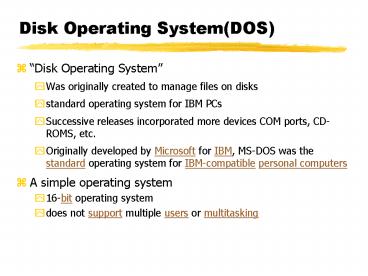Disk Operating SystemDOS PowerPoint PPT Presentation
1 / 8
Title: Disk Operating SystemDOS
1
Disk Operating System(DOS)
- Disk Operating System
- Was originally created to manage files on disks
- standard operating system for IBM PCs
- Successive releases incorporated more devices COM
ports, CD-ROMS, etc. - Originally developed by Microsoft for IBM, MS-DOS
was the standard operating system for
IBM-compatible personal computers - A simple operating system
- 16-bit operating system
- does not support multiple users or multitasking
2
Office Analogy
- Consider an office area
- You - like a computer processor - the device that
performs the work - Workspace/Desk - like memory(RAM)
- storage space (filing cabinets, drawers, etc.) -
like permanent storage(disks) - tools (pencils, pens, rulers, calculators, etc) -
like IO devices - A sample task to work on a file, go to a drawer,
pull out the file, open the file file the
document you need and put on your desk - like the
OS pulling a program from disk, loading it in
memory, and executing it - The basic functions of an operating system(DOS)
are - File management - analogous to the file cabinet
and its use - Working with the Files Devices - analogous to
picking up and preparing to use a calculator or
some other tool - Configuration of your working environment -
analogous to shifting your desk around to suit
you better
3
DOS Command Shell
- The command shell is the program that executes
operating system commands - interactive
- i.e. a means to interact with the OS
- waits for user inputs
- verifies it is correct(syntax checking)
- passes the command to the operating
system(command processor) to be executed - The command prompt
- C\MYDIR\gt
- Why learn the shell - cant I do everything from
Windows? - In Windows NT, some admin commands can only be
done from the shell
4
DOS Commands
- How the user talks to DOS
- Syntax
- DOS requires commands in a specific format, for
DOS this is - command_name parameters switches
- parameters - what you want the command to act on
- switches - turn on optional command functions
- ex. dir a /p - directory command on disk a
switch /p(pause) - Dont know the exact command syntax? Use /?
Switch - ex. dir /? - gives parameters and switches
- Enter command at the prompt(gt)
- if syntax is correct, it is executed when you
press Enter - DOSKEY
- keeps a history of executed commands so you can
use arrow keys to retrieve them
5
Formatting Disks
- You must format a disk before it can be used
- most floppy disks sold today are preformatted
- The DOS format command prepares a disk by
- Creating a map on the disk, magnetically
marking tracks sectors - Checking the disk for defects
- identifying bad sectors that should not be used
- Creating a root directory
- Setting up the File Allocation Table(FAT)
- the storage table that identifies the files on
the disk and where they are located(at a minimum) - recall that formatting doesnt erase disk data -
just the FAT - Bootable disk
- a disk that has the operating system files
necessary to start DOS - to create a bootable DOS disk, format with /s
switch
6
DOS File Management Commands
- DIR
- Directory Command - lists all the files in a
directory/folder - DIR A more
- CD
- Change Directory - allows you to move around the
directory tree - CD C\WINDOWS\TEMP
- MKDIR
- Make Directory - create a new directory/folder
- MKDIR C\TEMP\MYNEWDIR
- COPY
- copies a file to a new location/name
- COPY SOURE.TXT DEST.TXT
- MOVE
- moves the file to a new location/name(deletes
original) - DEL
- removes the file
- DEL BOGUS.TXT
7
Working with Files
- Recall 2 types of files used by OS
- binary(raw bytes) text(ASCII characters)
- How does DOS tell the difference?
- Usually by the files extension (the part after
the . in the name) - ex.
- .txt, .bat text files
- .exe, .com binary(executable) files
- Text files can be viewed from DOS with the TYPE
command - type myfile.txt /p
8
Miscellaneous
- Wildcard Characters ?
- matches any group of characters
- COPY .TXT A - copies all files ending in .TXT
to A - COPY . A - copies all files from the current
working directory to A - ? Matches any letter
- current working directory
- the directory the DOS command shell is currently
in - DISKCOPY
- copies an entire disk at a time
- DISKCOPY A A to copy a floppy

